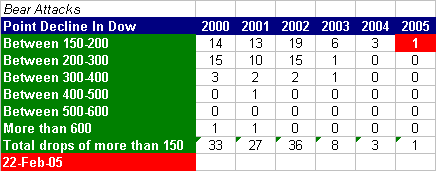|
After only the second 100+ point decline this year, the world’s most followed stock index (DJIA) is now 1.59% lower than it was on December 31, 2004. Following a weak January (even as money poured into mutual fund coffers), it goes without saying that yesterday’s broadly-based decline has got the bears stirring again. However, one day may not a resumption of the bear market make.
What to think about
Traditional valuations on U.S. stocks remain rich, year-over-year earnings comparisons are about to get a lot tougher, SOx 404 and FASB 123R must be adopted by companies this year, and he U.S. economy has shown signs of slowing down (the latest report confirming the slow down trend being yesterday’s drop in consumer confidence). As if all of this uncertainty were not enough, the Fed is likely to continue raising interest rates until something goes pop (i.e. the housing market), hedge funds continue to take greater control of every major financial market, insiders continue to sell stocks, and the declining/volatile U.S. dollar is an ever-present unknown.
These points and others are enough to make any beaten up bear grin. But alas, given that the stock markets are largely the product of unpredictable shifts in investor sentiment, only one point is really worth thinking about: the 200 DMA. Quite frankly, until the major U.S. markets sell off below this technical area the bear arguments lack bite, and a predicting any shift in investor sentiment remains difficult.
DJIA - 10,306.87
Yesterday’s decline notwithstanding, the DJIA has been in recovery mode since early 2003. Moreover, this recovery has yet to face any serious challenge. For example, in 2004 – a year when the markets traded lower until the U.S. elections neared – the DJIA dropped by more than 150 points only 3-times. Granted, the summer of 2004 was trying as the DJIA bounced around its 200DMA and investor’s fretted economic slow down scenarios. Nevertheless, during the bear years the Dow dropped by more than 200-points on a regular basis, and in the year 2002 the Dow dropped by more than 150 points 14% of the time. That the best the bears could muster in 2004 was 3 wipe-outs (150+ point declines) tells of a stable year for stocks.
 |
On April 14, 2000 the DJIA dropped by 612 points. Does anyone remember April 14, 2000? I do. On this day oil didn’t spike, the U.S. dollar didn’t collapse, and no mentionable earnings warnings crossed the wires. In fact, you would be hard pressed to find any extraneous event that prompted the April 14, 2000 sell off. What did happen on April 14, 2000 is that he Dow broke below its 200DMA. Point being, selling begets selling: only after a series of stock market shakeouts will investor sentiment toward stocks be threatened, and only after a breach of the DJIA’s 200DMA will professional money managers give in to the idea that the bear is back.
In short, the heart of the post-Iraq and post-election U.S. stock market rallies is the 200DMA. And while the heart of the matter may appear far off, two more days like yesterday is all it takes…
|